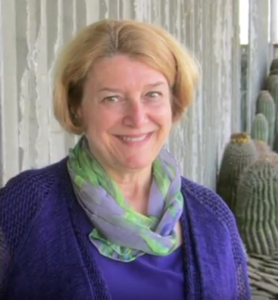
Joan Fudala (pictured above, outside Western Spirit)
1. Can you tell us something about your background and how you became interested in the story and art of the American West?
I was born in Ohio and came to Arizona for the first time in 1961. The wide open sky and landscape, not cowboys, that attracted me. That, and my fascination with Native American culture and the kind of exploring that I had seen in the television series Wagon Train. After college, I became a pioneer in my own way—I was the first woman commissioned to the Air Force ROTC, assigned to Luke AFB in 1976 and was stationed there for two years. After I married in 1978, I embarked on a career in public relations where I always tried to weave history into everything I did. In 1991 I took charge of PR for the Scottsdale Visitor and Convention Bureau. Since my retirement from that position, I have become a full-time historical consultant for the City of Scottsdale. I’ve written seven books and focused on developing programs for the library and digitizing over 10,000 historical photographs of the area.
Art and artists have always influenced Scottsdale, just as the natural beauty of the area has attracted artists, but it was a very open, welcoming place. There was never a cliquey art community and Winfield Scott, one of the founders and namesake of the city, supported women as equal partners, which is why artists like Jessie Benton Evans and Marjorie Thomas found a home here. The first art colony was founded in the 1920’s by Garnett Davy Grosse whose efforts grew into National Art Week, which observed across the nation.
I was thrilled to be a mayoral appointment to the Western Spirit Board.
2. If you were to meet someone who has never been to Western Spirit, but was thinking about visiting the museum, what would you say to them? Why are museums, especially those like Western Spirit, important today?
Everything is authentic. There’s nothing of the faux West in the museum. It truly represents the Western Spirit—the landscape, the people, the cultures. There’s amazing variety within the museum. It’s more than an art museum, more than an artifact museum. The programming alone—which, sadly, was curtailed by Covid—is incredible. Fortunately, since the opening of the Edward Curtis exhibition, the museum it beginning to host in-person events again.
For those who are new to the area, whether they have moved here or are visiting, Western Spirit offers a real sense of place and belonging. Visitors will come away with an appreciation of our stories—from the local to the regional—and will begin to understand what it means to live in the West and to feel and be a part of the West.
3. Can you tell us about a favorite object in the museum, what interests you about it, and why others should experience it for themselves? Perhaps a hidden gem or an object that connects the past of the American West to the present—and future?
So many. Because of my interest in all things Scottsdale and the lore and lure of the local, the exhibition of Marjorie Thomas’s work—she was the first woman artist to settle in Scottsdale—and the Arizona Craftsmen show in 2017 stand out.
But on the Second Floor, the Native American objects are equally amazing, as are the early paintings by George Catlin and others. Those really exude a sense of the long history of the West. One painting, The Mountain Man with Long Rifle, 1931, by W.H.D. Koerner, which is part of the Courage and Crossroads exhibition, is of special interest to me because of its tie to the story of the arts Scottsdale. Koerner’s work was exhibited at the very first exhibition in the Municipal Art Gallery in 1975 and seeing one of his paintings in the Western Spirit galleries brings that full circle.
The new Edward Curtis exhibition shows off Western Spirit’s versatility beyond paintings and artifacts, presenting the stories and technical prowess behind his extraordinary photographs—the historical context and process—even the controversies—not just the products. The stories are prompts for incredible discussions throughout the exhibition.
